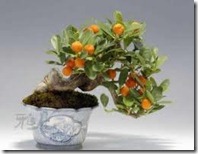 Bonsai Tree first appeared in China over a thousand years ago on a very basic scale, known as pun-sai, where it was the practice of growing single specimen trees in pots, which is know today as bonsai pots. These early specimens displayed sparse foliage and rugged, gnarled trunks which often looked like animals, dragons and birds.
Bonsai Tree first appeared in China over a thousand years ago on a very basic scale, known as pun-sai, where it was the practice of growing single specimen trees in pots, which is know today as bonsai pots. These early specimens displayed sparse foliage and rugged, gnarled trunks which often looked like animals, dragons and birds.
There are a great number of myths and legends surroundingChinese bonsai, and the grotesque or animal-like trunks and root formations are still highly prized today. Chinese bonsai come from the landscape of the imagination and images of fiery dragons and coiled serpents take far greater precedence over images of trees- so the two forms of this art are quite far apart.
With Japan’s adoption of many cultural trademarks of China – bonsai was also taken up, introduced to Japan during the Kamakura period (1185 – 1333) by means of Zen Buddhism – which at this time was rapidly spreading around Asia.
The exact time is debatable, although it is possible that it had arrived in AD 1195 as there appears to be a reference to it in a Japanese scroll attributed to that period. Once bonsai was introduced into Japan, the art was refined to an extent not yet approached in China.
Over time, the simple trees were not just confined to the Buddhist monks and their monasteries, but also later were introduced to be representative of the aristocracy – a symbol of prestige and honour. The ideals and philosophy of bonsai were greatly changed over the years. For the Japanese, bonsai represents a fusion of strong ancient beliefs with the Eastern philosophies of the harmony between man, the soul and nature.
In an ancient Japanese scroll written in Japan around the Kamakura period, it is translated to say : “To appreciate and find pleasure in curiously curved potted trees is to love deformityâ€. Whether this was intended as a positive or negative statement, it leaves us to believe that growing dwarfed and twisted trees in containers was an accepted practice among the upper class of Japan by the Kamakura period.
By the fourteenth century bonsai was indeed viewed as a highly refined art form, meaning that it must have been an established practice many years before that time.
Bonsai were brought indoors for display at special times by the ‘Japanese elite’ and became an important part of Japanese life by being displayed on specially designed shelves. These complex plants were no longer permanently reserved for outdoor display, although the practices of training and bonsai pruning did not develop until later – the small trees at this time still being taken from the wild.
In the 17th and 18th century, the Japanese arts reached their peak and were regarded very highly. Bonsai again evolved to a much higher understanding and refinement of nature – although the containers used seemed to be slightly deeper than those used today.
The main factor in maintaining bonsai was now the removal of all but the most important parts of the plant. The reduction of everything just to the essential elements and ultimate refinement was very symbolic of the Japanese philosophy of this time – shown by the very simple Japanese gardens such as those in the famous temple – Roan-ji.
At around this time, bonsai also became commonplace to the general Japanese public – which greatly increased demand for the small trees collected from the wild and firmly established the artform within the culture and traditions of the country.

Deprecated: strpos(): Passing null to parameter #1 ($haystack) of type string is deprecated in /home/agriviek8Qv/agriviet.net/public_html/wp-includes/comment-template.php on line 2522